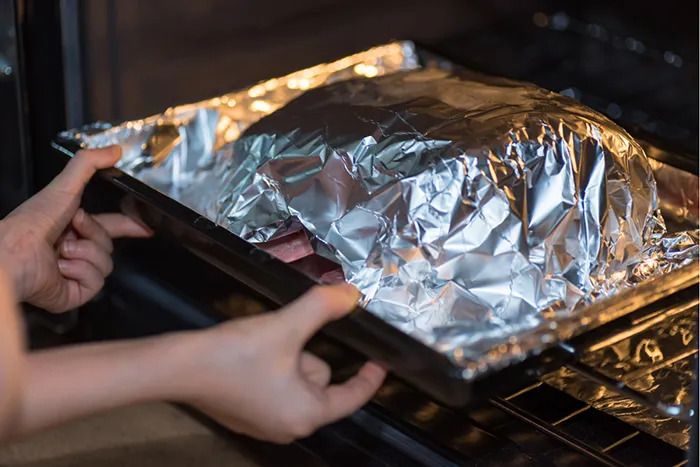What Should You Not Do With Aluminium Foil?
Here are things not to do with aluminum foil:
Don’t use aluminum foil in the microwave
Aluminum foil can create sparks in the microwave, which can cause a fire hazard. In addition, using aluminum foil in the microwave for a long time may even damage the internal components of the microwave.
Avoid storing acidic foods in aluminum foil
Highly acidic foods (such as tomatoes, citrus fruits, or vinegar-based sauces) react with aluminum, creating a metallic taste and, in some cases, causing the foil to decompose. It is recommended that you use glass or plastic containers to store acidic foods, or wrap them in wax paper or parchment paper before using aluminum foil.
Don’t over-crumple or twist aluminum foil
Over-crumpling or twisting aluminum foil can create sharp edges that can easily cut your hands.
Don’t let aluminum foil contact with hot grill surfaces
On a hot grill, aluminum foil may burn, melt, or even decompose, affecting the grill and the food. It is recommended that you use grill mats or special baking sheets designed for high-temperature applications.
Which Side Of The Aluminum Foil Should Touch The Food?
As a professional aluminum foil manufacturer, there is very little difference in reflectivity between the two sides of the foil, and both sides can contact the food. However, the food will cook slightly easier with the shiny side facing the food.

Because the shiny side of the foil reflects heat better than the dull side. When wrapping food, the shiny side facing inward may help retain heat and cook the food more efficiently by reflecting heat back onto the food.
If you want to retain moisture in the food (such as when roasting vegetables or grilling fish), the shiny side contacting the food will allow it to retain more moisture.
In fact, for baking, roasting or grilling, the difference in cooking results when using the shiny or dull side of the foil is negligible. Both sides are equally suitable for covering or wrapping food. The shiny side is just a small detail that may slightly affect heat reflection, but it is not a major factor.
Are Tin Foil And Aluminum Foil The Same?
Although tinfoil and aluminum foil are often used interchangeably, they are not the same thing.
Tin foil is made from thin sheets of tin (Sn), while aluminum foil is made from thin aluminum (Al). Aluminum foil became more popular after World War II because it is stronger, more flexible, and corrosion-resistant. Tin is more brittle than aluminum and tends to react with certain foods. Aluminum foil is more flexible and durable, and it also has better thermal conductivity and reflectivity for everything from wrapping food to lining baking sheets or grills.
True tinfoil is rarely used today because of its higher cost and less-than-ideal performance. However, people sometimes still refer to aluminum foil as “tinfoil” out of habit or tradition. Aluminum foil is a standard material in today’s homes and is what most people use when referring to “tinfoil” in a modern context. All tinfoil on the market today is actually aluminum foil.
Can You Put Aluminum Foil In The Oven Without A Pan?
It is not recommended to place aluminum foil directly on oven racks or on the bottom of the oven without a pan.

When aluminum foil is placed directly on the oven’s heating element or rack, the intense heat may cause the foil to burn or melt, especially if it is in direct contact with the heating coils. This can make cleanup a hassle and may cause permanent damage to the oven. Additionally, when aluminum foil is used directly on the oven’s racks or bottom, it can trap air and prevent the proper flow of heat around the food, affecting the final texture or consistency of the dish.
If you use aluminum foil to wrap food directly on the rack, the food may stick to the foil and be difficult to remove.
Tips for the proper use of aluminum foil in the oven:
- Spreading on a baking pan: A safer and more effective way to use aluminum foil in the oven is to spread it on a baking sheet or pan. Just make sure the foil is not directly touching the oven element or walls.
- Covering food: Aluminum foil can also be used to cover food during cooking or baking to retain moisture or prevent overbrowning.
Why Is One Side Of Foil Shiny?
The difference between shiny and dull sides of aluminum foil is in the manufacturing process, not the material itself.
Aluminum foil is made by rolling large sheets of aluminum metal into very thin sheets. During the final rolling stage, the side of the foil that comes in contact with the smooth rollers is shiny because the rollers create a smooth surface. The side that comes in contact with the rougher surface of the other sheet of foil is dull because it is not in direct contact with the smooth rollers and has a slightly rougher texture.
Does Aluminum Foil Keep Things Hot Or Cold?
Yes, aluminum foil can help keep things hot or cold to some extent. Here’s a closer look at how foil affects the effectiveness of keeping things hot:

The shiny side of foil reflects heat, keeping food warm. When you wrap food in foil or cover a plate with foil, the shiny side reflects heat back onto the food. This is why foil is often used to wrap foods like baked potatoes, meats, or hot sandwiches.
Aluminum foil acts as a barrier to heat transfer. It doesn’t conduct heat well, so when wrapped around hot foods, it can prevent heat from escaping, especially when combined with other materials like towels or insulated bags.
What Is The Shelf Life Of Aluminum Foil?
The shelf life of aluminum foil is essentially indefinite as long as it remains unopened and unused. Aluminum foil does not spoil or degrade over time like food or other materials do.
If kept in a dry, cool environment and in its original, unopened packaging, aluminum foil can last for years without any degradation. Once a roll of aluminum foil is opened, it still has a long shelf life. As long as the foil is kept dry and not damaged (such as torn, bent, or exposed to moisture), it can still be used for many years.
While aluminum foil itself is not prone to corrosion, exposure to moisture can cause it to weaken or deteriorate over time. Keeping aluminum foil away from wet areas ensures that it maintains its integrity.
What Does Aluminum Foil Do To Water?
Aluminum foil interacts with water in a few ways, depending on the situation. Here are the main things that aluminum foil does when it comes in contact with water:
Aluminum foil is waterproof, and when you wrap or cover food with it, it keeps moisture in. For example, you can wrap food like fish, potatoes, or chicken in foil before baking or grilling, which helps keep moisture in while preventing the food from becoming soggy from contact with water.
Aluminum foil can be used as a temporary waterproof layer in a variety of situations, for example, when camping, aluminum foil can be used to cover items like firewood or equipment to keep them dry. You can make aluminum foil into a makeshift bowl or lid for small amounts of water.
Is Aluminium Foil Safe To Wrap Hot Food?
Aluminum foil is safe for wrapping hot foods.
Because it is heat resistant, aluminum foil can withstand high temperatures without degrading or releasing harmful substances. It can withstand temperatures up to about 1,220°F (660°C) before it starts to melt. Since most cooking temperatures are well below this (baking is usually below 500°F), aluminum foil is perfect for wrapping hot foods. As long as you are not using aluminum foil to wrap acidic foods, aluminum foil is safe to use.



